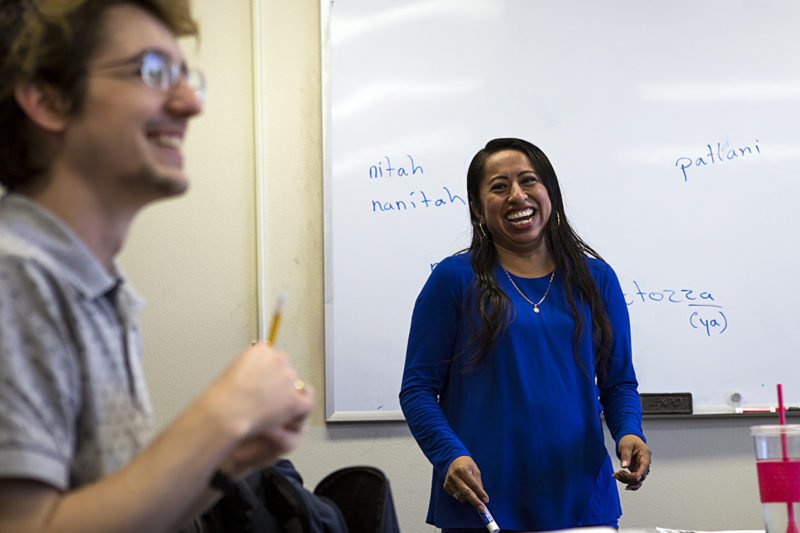UT’s Teacher of the Aztec Language Looks Back on Two Years in Austin
By Jesús Nazario
Reporting Texas

Saby Cruz de la Cruz is finishing up two years of teaching Nahuatl, the language of the Aztecs, at the University of Texas at Austin. Jesús Nazario/Reporting Texas
Chili, chocolate, avocado, tomato and coyote.
They’re all English versions of words in Nahuatl, the language the Aztecs spoke when the Spanish invaded Mexico in 1519. The language is still spoken by more than 1.5 million in at least 11 Mexican states, according to that nation’s 2015 census. It’s also taught at the University of Texas at Austin.
Sabina Cruz de la Cruz, who goes by Saby, is from a small town in Mexico’s Veracruz state. She has been in Austin for the last two years teaching the language in UT’s Latin American Studies indigenous language program. Nahuatl is pronounced as “na-watɬ” or “na-wua-tel.”
Cruz, 34, is headed back to Mexico soon. For the next two years, UT will teach K’iche’, the language of the Maya, the civilization responsible for the great ruins throughout Central America. Then it’s back to Nahuatl for two years.
UT’s program reflects a widespread interest among American colleges in preserving languages of Mexico and Central America. Adam Coon, an assistant professor at the University of Minnesota-Morris who specializes in Nahuatl literature, says it’s also taught at Tulane, Yale, Stanford and other universities.
“A lot of people don’t know about Nahuatl because [Nahuatl speakers] don’t speak it in public because they sometimes face discrimination, not just from Latinos but people in the U.S. as well,” he said in a telephone interview. “But the language is important, because I think it can help people of Mexico and the U.S. to understand and hear the perspectives of another language and another way of life, whether you express yourself in Nahuatl or in another language.”
Sergio Romero, a Spanish and Portuguese assistant professor and director of UT’s indigenous language program, says he recruited Cruz from Tulane University, where she had taught Nahuatl since 2009. When Nahuatl is next taught, he says, classes will be offered by the semester instead of the year-long classes Cruz taught. Nahuatl attracted fewer than 10 students a year in its first run.
“When we teach Nahuatl again, we will change it from an intensive six-hour course to a three-hour course to draw more students in,” Romero said in an interview.
Cruz’s trip from a Veracruz village of about 700 to Austin took her first to the Zacatecas Institute for Teaching and Research in Ethnology, where she learned how to read and write in Nahuatl, which she had been speaking since she could talk.
“This began my journey to become a teacher,” she said in an interview. “I could speak the language, but I didn’t know how to write it down. After that, I got certified to teach.”
In 2009, she began teaching every spring at Tulane in New Orleans. After Tulane, she moved to Austin in fall 2015 for a two-year stint. The experience has had its challenges, she says, mainly that she couldn’t use her native language outside the classroom.
“I wasn’t able to find a Nahuatl-speaking community since I arrived,” she said. “But I was able to find students outside of the classroom wanting to learn Nahuatl. Right now, I’m teaching a small group on Sundays.”
For 21-year-old Yasmeen Davila, a third-year economics and history major at UT-Austin who took Cruz’s class, finding ways to practice Nahuatl outside the classroom has been a challenge.
“There’s history in language, and I really like being able to see the point of view of Nahuatl speakers,” she said in an interview. “But it’s hard to practice Nahuatl and become fluent when you only have your professor who knows Nahuatl, possibly in all of UT.”
Cruz says Austin has been good to her, though she hasn’t experienced a Texas drought.
“I like how Austin is always green. It reminds me of home,” she said. “In my community in Veracruz, you only see green … . When I’m in Austin, I feel the warmth of the city.”
She will do some work on a Nahuatl archive for UT when she returns to Zacatecas, which she calls home now. She’s not sure what her future holds, but she’s optimistic.
“Right now my future is unknown. I don’t have big plans,” she said. “I’m flexible. It’s how I am. I’ll adjust to whatever comes my way.”